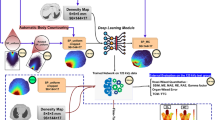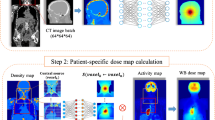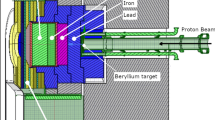Abstract
In-phantom figures of merit of the radiobiological dose distribution are the main criteria for evaluation of the boron neutron capture therapy (BNCT) plan and neutron beam evaluation. Since in BNCT there are several reactions, which contribute to the total dose of the tissue, the calculation of the dose distribution is complicated and requires lengthy and time-consuming simulations. Any changes in the beam shaping assembly (BSA) design would lead to the change of the neutron/gamma spectrum at exit of therapeutic window. As a result of any changes in the beam spectrum, the dose distribution in the tissue will be altered; therefore, another set of lengthy and time-consuming simulations to recalculate the dose distribution would have to be performed. This study proposes a method that applies artificial neural network (ANN) for quick dose prediction in order to avoid lengthy calculations. This method allows us to estimate the depth–dose distribution and in-phantom figures of merit for any energy spectrum without performing a complete Monte Carlo code (MCNP) simulation. To train the ANNs for modeling the depth–dose distribution, this study used a database containing 500 simulations of the neutron depth–dose distribution and 280 simulations of the gamma depth–dose distribution. The calculations were carried out by the MCNP for various mono-energetic neutrons, ranging from thermal up to 10 MeV energy and 280 gamma energy group, ranging from 0.01 MeV up to 20 MeV, through the SNYDER head phantom which is located at the exit of the BSA. The trained ANN was capable of establishing a map between the neutron/gamma beam energy and the dose distribution in the phantom as an input and a response, respectively. The current method is founded upon the observation that the dose which is released by the beam of composite energy spectrum can be decomposing into the various energy components which make the neutron/gamma spectrum. Therefore, in this procedure the neutron/gamma energy spectrum was converted into several energy groups and dose response of each group was predicted by the trained ANN. Total dose distribution of the entire spectrum is equal to summation of dose response of each group. If the neutron/gamma spectrum as an input changes, the dose response of that as an output can be predicted by the trained ANN in no time rather than hours or days by MCNP simulations. To check the validity of this method, this study compared full calculation of the depth–dose distribution with prediction of ANN for that. The result of this comparison shows that artificial neural networks model the dose distribution in phantom successfully and result in a great accurate prediction.
















Similar content being viewed by others
References
IAEA-TECHDOC-1223, Current status of neutron capture therapy, May 2001
Nigg DW (2000) Some recent trends and progress in the physics and biophysics of neutron capture therapy. Prog Nucl Energy 35(1):79–127
Palmer MR, Goorley JT, Kiger WS, Busse PM, Riley KJ, Harling OK, Zamenhof RG (2002) Treatment planning and dosimetry for the Harvard-MIT phase I clinical trial of cranial neutron capture therapy. Int J Radiat Oncol Biol Phys 53(5):1361–1379
Waters LS (2002) MCNPX user’s manual version 2.4.0. Los Alamos National Laboratory Report LA-CP-02-408
Harling OK, Zamenhof RG, Bernard JA (1990) Monte Carlo based dosimetry and treatment planning for neutron capture therapy of brain tumors, in neutron beam design, development and performance for neutron capture therapy. Plenum, New York, pp 283–305
ICRU Report 46 (1992) Photon, electron, proton, and neutron interaction data for body tissues. International Committee on Radiation Units and Measurements, Bethesda, MD
ICRU Report 63 (2000) Nuclear data for neutron and proton radiotherapy and for radiation protection. International Committee on Radiation Units and Measurements, Bethesda, MD
Chanana AD, Med. Dep., Brookhaven Natl. Lab. Boron neutron-capture therapy of glioblastoma multiform at the Brookhaven medical research reactor, A phase I/II Study (FDA IND # 43,317), Protocol #4, Upton, NY 11973-5000, January, 1996
Vieira A, Fernandes A, Patrício A (2001) Optimization of neutron beams for BNCT using artificial neural networks, Proceedings of the WSES International Conference on Neural Networks and Applications, Tenerife, p. 38, 12-14
Christopher Bishop M (1995) Neural networks for pattern recognition. Oxford University Press, USA
Dayhoff JE (1990) Neural networks principles. Prentice-Hall International, Englewood Cliffs
Kozma R, Sakuma M, Yokoyama Y, Kitamura M (1996) On the accuracy of mapping back propagation with forgetting. Neurocomp 13(2–4):295–311
Demuth H, Beale M, Hagan M (2007) Neural network toolbox 5 user’s guide. The Mathworks, Natick
Kasabov NK (1998) Foundations of neural networks fuzzy systems and knowledge engineering. MIT Press, Cambridge
Author information
Authors and Affiliations
Corresponding author
Rights and permissions
About this article
Cite this article
Ahangari, R., Afarideh, H. A new approach to dose estimation and in-phantom figure of merit measurement in BNCT by using artificial neural networks. Australas Phys Eng Sci Med 34, 467–479 (2011). https://doi.org/10.1007/s13246-011-0107-z
Received:
Accepted:
Published:
Issue Date:
DOI: https://doi.org/10.1007/s13246-011-0107-z




